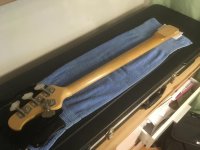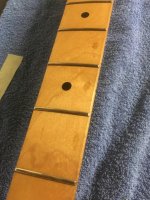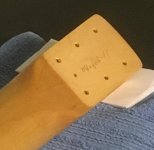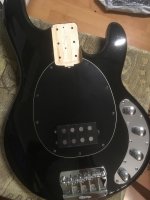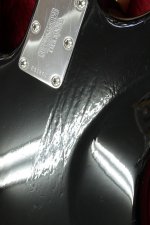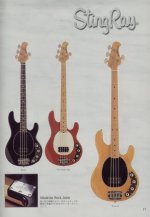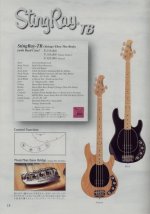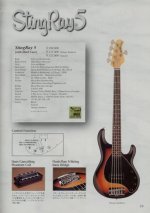So I've just hunted down a Japanese 3 band Stingray that needs a bit of love and care. A lovely lightweight (9 lbs) black/maple 4 stringer. Sounds great, neck is straight, has a couple of dings, scratches and true road wear, but I'm cool with it. Fantastic companion to my 2 band Stingray. I stripped it down, checked all the components and parts, and cleaned it up nicely. I was surprised on one thing though.
It's the usual oil & wax finish, but the fretboard is poly finished. I expected oil & wax even on the fretboard, but I guess they did this combo as well? Does anyone have knowledge on when EBMM did the combo oil/wax/poly on maple/maple necks and then switched to full on oil/wax on maple/maple necks?
I took the neck off, cleaned it nicely and started my usual Tru Oil process - I'm gonna add about 6-8 thin coats of Tru Oil on the neck to give it extra protection and seal it a bit. Did the same thing on my 2 band and I love it.
Anyways, you can see on the photos that the fretboard is poly finished because the finish is worn in couple of places (I'm mending those slightly too with Tru Oil).
Seller doesn't know the year of my Stingray, but I'm guessing late 90s early 2000s because it doesn't have the mute style bridge that MIJ Stingrays had in the beginning, nor the old school neck plate.
EDIT: Just for those who might not know about these MIJ Stingrays, here's a quote from EBMM: "The EX were made from the same materials as the StingRays that were produced in the US at that time. Predominantly ash bodies, alnico preamps, etc. They were done in the mid to late 90s and early 2000s." Kanda Shokai were the distributor and those were meant for the Japanese market. Real mojo machines if you ask me and a very cool piece of Stingray history.
It's the usual oil & wax finish, but the fretboard is poly finished. I expected oil & wax even on the fretboard, but I guess they did this combo as well? Does anyone have knowledge on when EBMM did the combo oil/wax/poly on maple/maple necks and then switched to full on oil/wax on maple/maple necks?
I took the neck off, cleaned it nicely and started my usual Tru Oil process - I'm gonna add about 6-8 thin coats of Tru Oil on the neck to give it extra protection and seal it a bit. Did the same thing on my 2 band and I love it.
Anyways, you can see on the photos that the fretboard is poly finished because the finish is worn in couple of places (I'm mending those slightly too with Tru Oil).
Seller doesn't know the year of my Stingray, but I'm guessing late 90s early 2000s because it doesn't have the mute style bridge that MIJ Stingrays had in the beginning, nor the old school neck plate.
EDIT: Just for those who might not know about these MIJ Stingrays, here's a quote from EBMM: "The EX were made from the same materials as the StingRays that were produced in the US at that time. Predominantly ash bodies, alnico preamps, etc. They were done in the mid to late 90s and early 2000s." Kanda Shokai were the distributor and those were meant for the Japanese market. Real mojo machines if you ask me and a very cool piece of Stingray history.
Attachments
Last edited:


